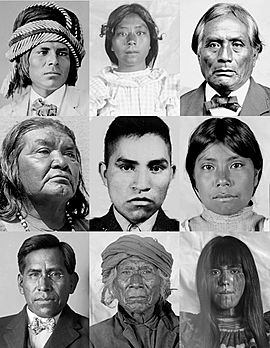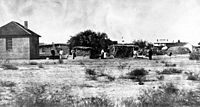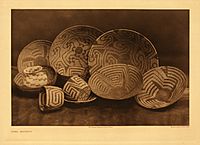Akimel O'odham facts for kids
|
O'odham portraits
|
|
| Total population | |
|---|---|
| 19,921 +/−4,574 (2010) | |
| Regions with significant populations | |
| Languages | |
| O'odham, English, Spanish | |
| Religion | |
| Roman Catholicism, traditional tribal religion | |
| Related ethnic groups | |
The Akimel O'odham are a group of Native Americans. Their name means "river people" in the O'odham language. They are also known as the Pima.
Most Akimel O'odham live in central and southern Arizona in the United States. Some also live in northwestern Mexico. They are part of two main groups in the U.S.: the Keli Akimel Oʼodham on the Gila River Indian Community and the On'k Akimel O'odham on the Salt River Pima-Maricopa Indian Community.
The Akimel O'odham are related to other O'odham groups. These include the Ak-Chin O'odham, Sobaipuri, Tohono O'odham ("Desert People"), and Hia C-ed O'odham ("Sand Dune People"). Together, these groups are sometimes called the Upper Oʼodham or Upper Pima.
The name "Pima" likely came from a misunderstanding. When Spanish explorers first met them, the O'odham often said pi 'añi mac or pi mac. This means "I don't know." The Spanish then started calling them "Pima." Later, English speakers also used this name.
Contents
Akimel O'odham History
Before Europeans arrived, the Pima people called themselves Othama. Spanish missionaries wrote down the names of some Pima villages. Later, these names were changed by European Americans. Today, the Akimel Oʼodham have their own names for their villages.
Experts believe the Akimel Oʼodham are connected to an ancient group called the Hohokam. The word Hohokam comes from the Oʼodham word Huhugam. This means "those who have gone before" or "The Ancestors."
The Upper Pima groups were divided based on their culture, way of life, and language.
River People and Desert People
One main group was the Pima or River Pima. They are now called the Akimel Oʼodham.
- The Akimel Oʼodham ("River People") lived and farmed along the Gila, Salt, and Santa Cruz rivers in Arizona.
- The On'k Akimel O'odham ("Salt River People") lived along the Salt River. They are now part of the Salt River Indian Reservation.
- The Keli Akimel Oʼotham ("Gila River People") lived along the Gila River. They are now known as the Gila River Indian Community.
- The Ak-Chin O'odham are part of the Ak-Chin Indian Community.
- The Sobaipuri originally lived along the San Pedro and Santa Cruz rivers. Over time, they moved west and joined the Tohono O'odham and Akimel O'odham.
The other main group is the Tohono O'odham or Desert Pima.
- The Tohono O'odham ("Desert People") lived in the deserts and mountains south of Tucson. The Akimel O'odham called them Pahpah Au-Authm, meaning "eating tepary beans." This name became "Papago" to the Spanish.
- The Hia C-eḍ O'odham ("Sand Dune People") lived in the deserts west of the Tohono O'odham. They were also known as "Sand Pimas."
The Akimel Oʼodham lived in villages made of loose groups of houses. These houses were called "Olas Ki:ki" (round houses) and were made of brush. Families often shared a central cooking area. Daughters and their husbands would live with or near the daughter's mother's family. They also had temporary homes near their farms.
All O'odham groups speak the O'odham language. There are some differences in how they speak, but they can all understand each other.
Ancient Economy and Skills
The Akimel Oʼodham mainly got their food by farming, hunting, and gathering. They also traded a lot. To grow crops in the dry land, they built a large system of irrigation canals. These canals are still used today.
The Akimel Oʼodham were skilled at making textiles. They created detailed baskets and woven cloth. Before Europeans arrived, their main rivals were the Apache and Yavapai tribes. These tribes were more nomadic and would sometimes raid the Akimel O'odham villages for food.
Later History (After 1694)
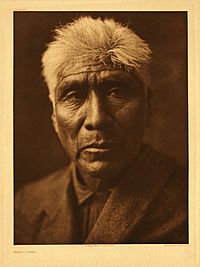
The Akimel Oʼodham did not have much contact with European settlers at first. The first recorded visit by a European was by Father Kino in 1694. Later, in 1751, there was a conflict known as the Pima Revolt or O'odham Uprising against Spanish forces.
When Mexico ruled southern Arizona (1821-1853), contact was still rare. However, the Akimel Oʼodham were affected by new things from Europe. These included diseases they had no protection against, new crops like wheat, farm animals, and metal tools.
After the Mexican–American War in 1846, more Americans came to the area. The Akimel Oʼodham helped American explorers and traders traveling to California. After Mexico lost the war, the U.S. gained southern Arizona in 1853 through the Gadsden Purchase.
During the California Gold Rush, many travelers passed through Akimel Oʼodham villages. These villages were like safe places where travelers could rest and get supplies. This led to a time of growth for the Akimel Oʼodham. The Gila River Indian Community was created in 1859.
After the American Civil War, more American settlers moved to the Gila and Salt Rivers. They competed for water and land, which caused problems. The U.S. government began to move Native Americans to reservations. This led to changes in how the Akimel Oʼodham lived. Towns like Vahki (Casa Blanca) and Gu U ki (Sacaton) grew as important centers.
By 1898, farming had almost stopped in the Gila River Indian Community. The Akimel Oʼodham had to find other ways to live, like cutting wood. In 1914, the government started dividing up tribal land into smaller plots for individual families.
A big effort to help the Akimel Oʼodham was the San Carlos Project Act of 1924. This plan was to build a dam on the Gila River to provide water for farming. However, the project did not work as planned for the Oʼodham. The dam stopped the flow of water to their lands. This made farming very difficult and led to hard times.
Over many years, the U.S. government tried to make the Akimel Oʼodham adopt American ways of life. But after World War II, the Akimel Oʼodham became more interested in their own tribal rights and economic growth. They have regained their self-government. They have also started successful businesses, including casinos, to create income. They are now building a new water system to help bring farming back to their lands.
Akimel O'odham and the Rivers
The Akimel O'odham ("River People") have lived along the Gila and Salt Rivers for a very long time.
Their way of life, called himdagĭ, is deeply connected to the river. The river is considered sacred. Himdag means more than just honoring the river. It includes their religion, morals, values, and how they see the world. Their beliefs are strongly linked to the natural world.
Today, the Gila and Salt Rivers are often dry. This is because of dams upstream and water being used by other farmers. This has caused great sadness and challenges for the Oʼodham people. The lack of water, along with dry weather, led to very difficult times for farming. This was a big change from how prosperous they had been before.
The issue of water rights led to a long legal fight between the Gila River Indian Community and the U.S. government. In 2005, the case was settled in favor of the Akimel Oʼodham. Sometimes, during the rainy season, the Salt River does flow, which is a reason for celebration.
The changes in water supply and the introduction of new foods are believed to be major reasons for the high rate of type 2 diabetes among the Akimel Oʼodham tribe.
Modern Akimel O'odham Life
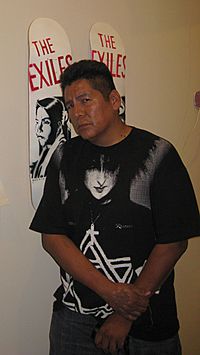
Today, most Akimel O'odham live in the Gila River Indian Community (GRIC). Many also moved north to the Salt River, forming the Salt River Pima-Maricopa Indian Community (SRPMIC). Both of these tribes also include the Maricopa people.
There are four federally recognized O'odham tribes in the Southwest that speak the same language:
- The Gila River Indian Community ("Gila River People")
- The Salt River Pima-Maricopa Indian Community ("Salt River People")
- The Ak-Chin Indian Community
- The Tohono O'odham Nation ("Desert People")
Another group, the Hia C-eḍ O'odham ("Sand Dune People"), is not federally recognized. They live in southwestern Arizona.
The GRIC is a self-governing tribe. It has over 550,000 acres of land in central Arizona. The community is divided into seven districts, each with its own local government. It is led by an elected Governor, Lieutenant Governor, and an 18-member Tribal Council. There are more than 19,000 members.
The Gila River Indian Community has many businesses. These include three casinos, golf courses, a resort, and an amusement park. They also manage industrial parks and farms. The Gila River Indian Reservation is home to both the Maricopa people and the Keli Akimel O'odham.
The Salt River Pima-Maricopa Indian Community is smaller. It also has an elected President and tribal council. They run tribal gaming, industrial projects, and construction supply businesses. This community is home to the Onk Akimel O'odham, the Maricopa of Lehi, some Tohono O'odham, and some Keli Akimel O'odham.
The Ak-Chin Indian Community is in the Santa Cruz Valley. It is mostly made up of Ak-Chin O'odham and Tohono O'odham, along with some Yoeme. The word Ak-Chin means "the mouth of the arroyo" or "where the wash disappears into the sand."
The Keli Akimel O'odham and Onk Akimel O'odham face health challenges. These are linked to changes in their traditional way of life and farming. They have a very high rate of type 2 diabetes. This is thought to be due to changes in their diet from traditional farm foods to processed foods, and less physical activity.
Akimel O'odham Customs
The Akimel O'odham believe names are very important. From age ten until marriage, boys and girls were not allowed to say their own names out loud. They thought this would bring bad luck. Similarly, people do not say the names of those who have passed away. This is to avoid calling their spirits back. However, the words in the names are still used in the language.
Children were carefully taught about morals, religion, and other important things. Their ceremonies often included special speeches. In these speeches, a speaker would tell parts of their creation stories. These stories were especially important before going to war. The speeches changed for each event, but the main message stayed the same.
Traditionally, the Pimas lived in huts called jacales. These huts were made of reed mats and built in a vault shape over arched sticks. They were covered thickly with mats to protect from the weather. Inside, they had simple sleeping mats and gourds for water.
Notable Akimel O'odham
- Natalie Diaz, poet, language activist, former professional basketball player
- Ira Hayes (1923–1955), Marine paratrooper and flagraiser at the Battle of Iwo Jima
- Douglas Miles, artist, social worker
- Big Chief Russell Moore (1912–1983), jazz trombonist
See also
 In Spanish: Pueblo pima para niños
In Spanish: Pueblo pima para niños
- Pima Indian Revolt
- O'odham language
- Man in the Maze
- List of dwellings of Pueblo peoples


